Coronary Graft Angioplasty Guided by Multi-Slice Computed Tomography
by
David Pesenti Rossi
January 3, 2012Operator(s)
David Pesenti Rossi, MD; Christophe Caussin, MD; Bernard Livarek, MD; Thierry Fourme, MD
Affiliation
Marie Lannelongue Hospital (France)
Facility / Institute
Rambouillet and Versailles Hospitals (France)
Clinical History
A 76-year-old man who underwent coronary artery bypass surgery in 1987 had 2 saphenous vein grafts to the mid-left anterior descending and marginal branch of circumflex coronary arteries.
PCI with bare metal stent implantation into the LAD bypass graft proximal anastomosis was performed in 2008. He presented with recurrent angina in 2009.
Angiography
Conventional angiography was marked by a failure of LAD bypass catheterization in 2009. Multi-slice CT revealed ostial bare metal stent deformation and significant in-stent restenosis of the LAD bypass proximal anastomosis that explained the catheterization failure (Figure 1).
Repeat coronary angiography was performed; the choice and the orientation of the catheter were guided by the CT data. We used a 6Fr IMA Launcher (Medtronic) and a BMW guidewire (Abbot) to secure the catheter into the bypass graft. Coronary angiography confirmed severe in-stent restenosis of the LAD bypass proximal anastomosis (Figure 2).
Repeat coronary angiography was performed; the choice and the orientation of the catheter were guided by the CT data. We used a 6Fr IMA Launcher (Medtronic) and a BMW guidewire (Abbot) to secure the catheter into the bypass graft. Coronary angiography confirmed severe in-stent restenosis of the LAD bypass proximal anastomosis (Figure 2).
Procedure
The BMW guidewire was positioned in the distal LAD saphenous vein graft. Two predilations were performed using a 2.5x15mm MAVERICK balloon (Boston Scientific) to 18atm. A 3.5x24mm TAXUS DES (Boston Scientific) was implanted at 15atm to treat the in-stent restenosis. The result was perfect with no angiographic residual stenosis and TIMI 3 flow (Figure 3, Figure 4).
Conclusion(s) / Result(s)
A new sixty-four slice CT was performed in 2011 and revealed an ideal stent position with aortic protrusion and no DES restenosis of the LAD bypass proximal anastomosis (Figure 5).
Comments/Lessons
In the case of restenosis and aortic stent protrusion, catheterization of the ostium of the saphenous vein graft may be challenging. CT may be a valuable tool to guide selective cannulation of the bypass graft. Moreover, the CT pulse acquisition and iterative reconstruction allow to obtain low dose and less artifacts due to stent.
Conflicts of Interest
None
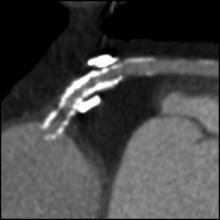
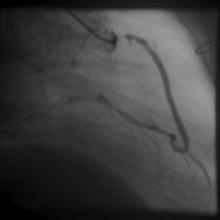
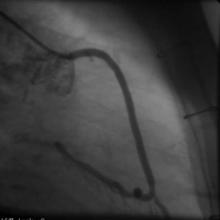
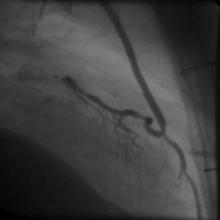
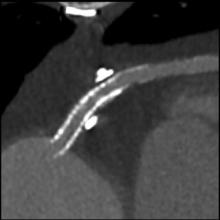
Comments